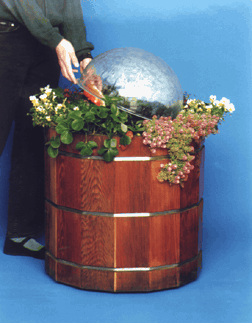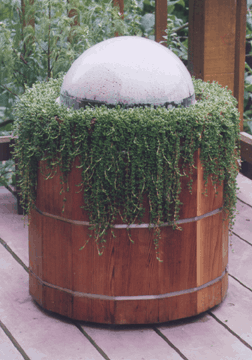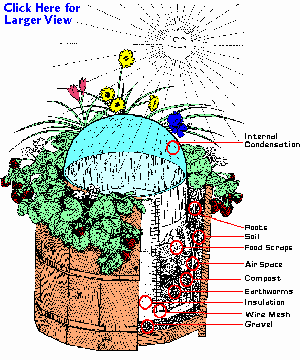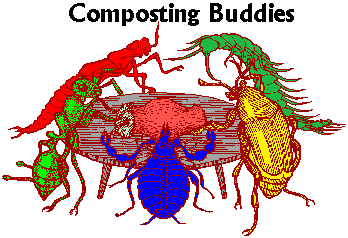|
|
|
Scrap Eater |
 A
Stylish, High-Tech Composter
A
Stylish, High-Tech ComposterCreating mineral-rich soil from your table scraps is finally convenient, clean and easy with the Sun Frost Scrap Eater - a state of the art "living machine." This composter is a highly functional piece of appropriate technology that is also stylish and fun to use.
Plants growing in the soil on the perimeter of the Scrap Eater feed
directly off nutrients that you create in the composting section. This
miniature ecosystem composts food scraps in a sealed compartment so you
can display the Scrap Eater on a deck, porch or even an apartment patio
without concern about odors, insects or animals.
Composting is an environmentally friendly way to get rid of your kitchen and garden scraps. Microorganisms in the compost cleanly and conveniently convert plant scraps into humus, the same natural fertilizer that develops on the forest floor and nourishes the world's trees. The Scrap Eater helps keep your garbage can clean and odor-free by accepting foods that would otherwise rot and produce odors. It saves you money on trash pickups and extends the life of landfills.
You will enjoy this beautiful addition to your home for many years. The Scrap Eater is an attractive garden planter, as well as an efficient composter. It is manufactured by Sun Frost, the company that pioneered energy-efficient refrigerators. Sun Frost has applied its experience in industrial design and solar technology to create the most effective, sturdy and compact composter on the market. Measuring two feet high and two feet in diameter, this composter is constructed of second-growth redwood, a wood that is naturally impervious to fire and rot. The clear dome is made of acrylic plastic, a material that resists solar degradation.
 A
LIVING MACHINE
A
LIVING MACHINEThe Scrap Eater is the only truly solar-powered composter. The composting process is accelerated by the warm environment. Using conventional techniques a compost pile at least 3 ft. across is needed to obtain necessary elevated temperatures. To compensate, the Sun Frost Scrap Eater uses solar architectural techniques, glazing and insulation to attain elevated temperatures. The solar heat collected through the dome, along with the heat generated internally by the respiration of the composting microbes is trapped by the insulated walls of the composting chamber. A unique feature of this insulation is its ability to keep the heat in, while it allows oxygen to freely flow to the composting microbes.
The unique shape of the acrylic bubble not only collects solar energy, but channels water to where it is needed most. Water that condenses on the inside of the dome runs down to the plants on the perimeter of the barrel. This process has a dual purpose. First, it reduces the need to water the plants because they are receiving water from the condensation under the dome. Second, the water is flowing to the outer perimeter rather than dripping into the composting chamber, which reduces the moisture level of the compost and the amount of dry material which must be added to the compost.
When the plants growing on the perimeter of the composter mature they will extend their roots to the bottom of the compost chamber and directly extract nutrients and moisture from the composted food scraps. This process continues the natural cycle much like it occurs in the wider biosphere.
The Scrap Eater is easy to use - you add your kitchen scraps several times a week. Periodically, you mix the pile with the supplied stirrer and add some dry material to the mix - a scoop of peat moss, some dry leaves, or a little sawdust. The Scrap Eater is emptied when it fills up - six months for a family of four, and two years or more for a single-person household. What comes out - the compost - is a perfect plant fertilizer that can be used anywhere in your garden, including the growing area on the perimeter of the Scrap Eater.
 HOW
IT WORKS
HOW
IT WORKSThe Scrap Eater can be used to rapidly compost large batches of food scraps at one time, but is typically used by adding small amounts of scraps every few days. The ability of the composter to rapidly decompose food scraps decreases the rate at which the chamber fills up. As food scraps decompose they will decrease in volume by 20 times or more. Where does the food go? Part of the material is lost through evaporation, but most of the scraps are consumed by the hungry microbes in the composter and exhausted as carbon dioxide and water vapor.
If large quantities of food are added at one time, higher composting
temperatures may be attained. Temperatures as high as 150°F may be
generated with the addition of at least 1 cubic foot of the right
combination of food and dry material. Conventional composters require 30
times the material to reach these high temperatures.
 VERMICULTURE
VERMICULTUREWorms may also be added to the Scrap Eater to assist in the composting process. They help to aerate the soil while producing a very effective soil additive. The compost chamber will typically be 30°F above the ambient temperature and during the summer may be too hot for the worms. To avoid these warm conditions the worms will migrate to the cooler perimeter where the plants are growing. As they migrate, nutrients from the composting area will be transported to the plants growing on the perimeter.
| Knot Work |  |
Web Weaving |